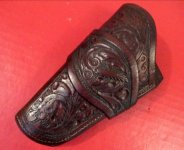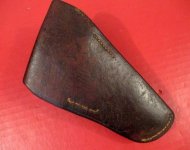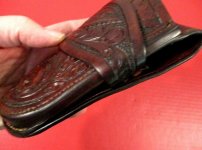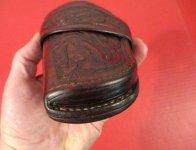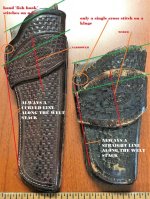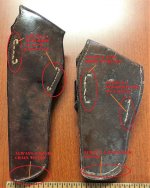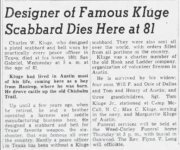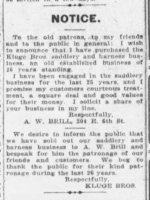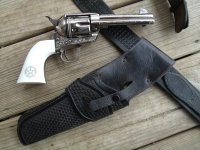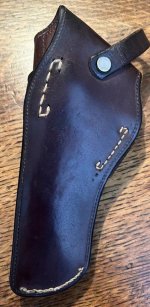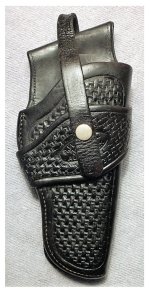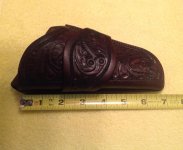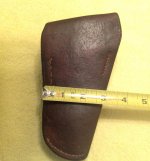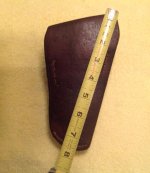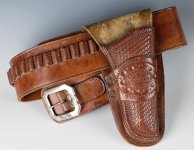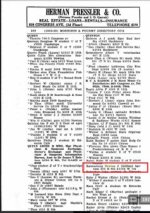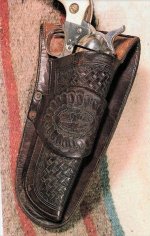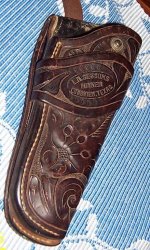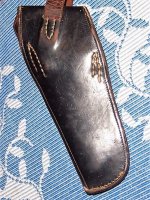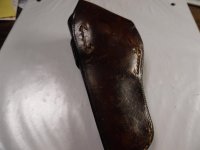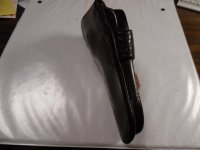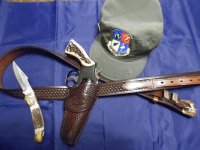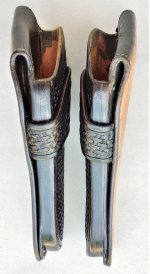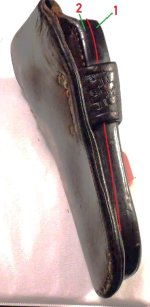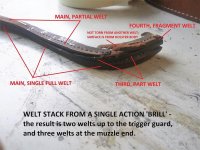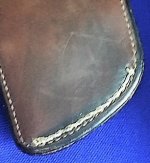I have recently acquired a Brill-style scabbard. It was determined by the experts that it was made by Charles Kluge of the Kluge Brothers Saddlery between 1906 and 1912. The company was a significant downtown Austin leather enterprise, being in business for 20 plus years in 1906. By 1912, the A.W. Brill Company took over the Kluge Brothers Saddlery, but the brothers remained on as employees.
According to Red Nichols, "Charles Kluge of Kluge Brothers was the innovator who created the style for Captain Hughes in 1906; it was long thought it was N.J. Rabensburg but period news articles put us straight on that. Rabensburg likely was at Kluge Brothers saddlery as a saddle cub at that time.
Kluge made the scabbards, in the familiar basketweave and in that particular carving style, too, from then until 1912 when A.W. Brill bought out the Kluge Brothers saddlery. From then on they were the same scabbards but with the A.W. Brill stamp in the center of the leather cuff. The welt stack of these Kluge scabbards are always quite straight, the cuffs are wide, the tip ends of the cuffs are sewn to the fender in just that way, and there is just one welt inside the welt stack.
It was in 1932 that Rabensburg joined Brill to eventually replace Charles Kluge who would die a decade later. Rabensburg changed the style of the holster and including that carving; added a second and even third welt, contoured the main welt stack, changed the hand sewing of the cuff ends, added a stitch to the open end of the welt stack."
I contacted some of the owners of the known Brill-style scabbards on the forum and thought a new thread should be started to limit confusion. Hopefully, as more scabbards are identified that fit this description, they will be posted here, so we can discuss them. These scabbards are fairly easy to identify when looking at the rear and welt of the scabbard. Here are pictures of my scabbard:
Larry
According to Red Nichols, "Charles Kluge of Kluge Brothers was the innovator who created the style for Captain Hughes in 1906; it was long thought it was N.J. Rabensburg but period news articles put us straight on that. Rabensburg likely was at Kluge Brothers saddlery as a saddle cub at that time.
Kluge made the scabbards, in the familiar basketweave and in that particular carving style, too, from then until 1912 when A.W. Brill bought out the Kluge Brothers saddlery. From then on they were the same scabbards but with the A.W. Brill stamp in the center of the leather cuff. The welt stack of these Kluge scabbards are always quite straight, the cuffs are wide, the tip ends of the cuffs are sewn to the fender in just that way, and there is just one welt inside the welt stack.
It was in 1932 that Rabensburg joined Brill to eventually replace Charles Kluge who would die a decade later. Rabensburg changed the style of the holster and including that carving; added a second and even third welt, contoured the main welt stack, changed the hand sewing of the cuff ends, added a stitch to the open end of the welt stack."
I contacted some of the owners of the known Brill-style scabbards on the forum and thought a new thread should be started to limit confusion. Hopefully, as more scabbards are identified that fit this description, they will be posted here, so we can discuss them. These scabbards are fairly easy to identify when looking at the rear and welt of the scabbard. Here are pictures of my scabbard:
Larry
Attachments
Last edited:

